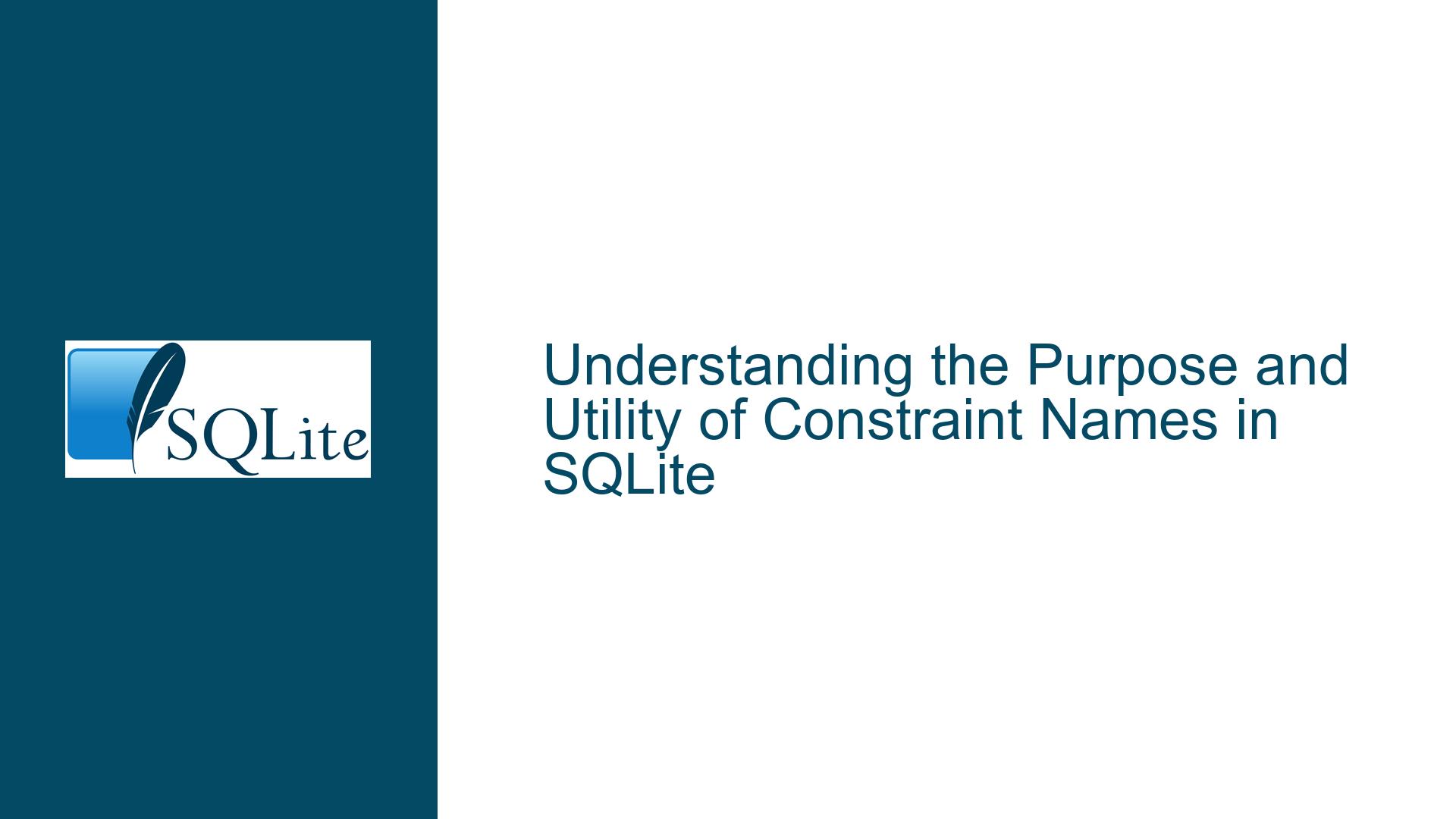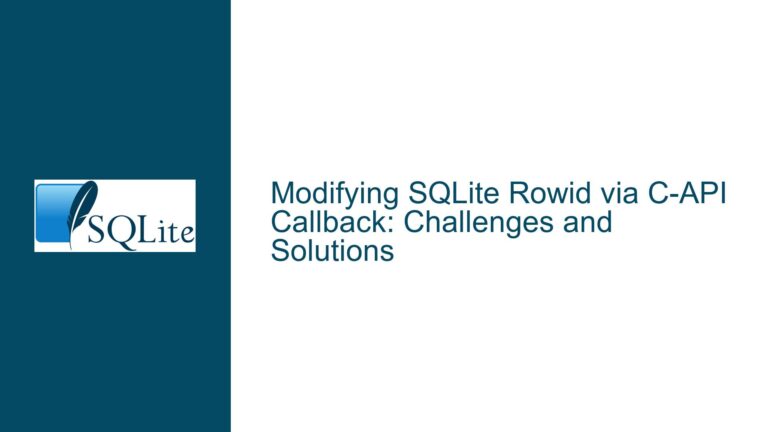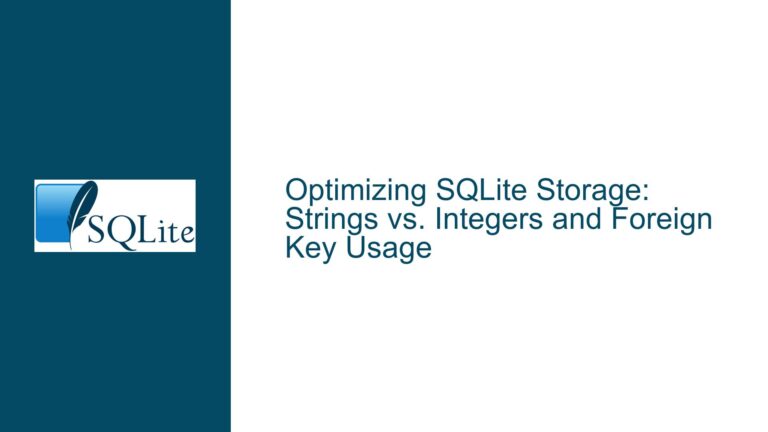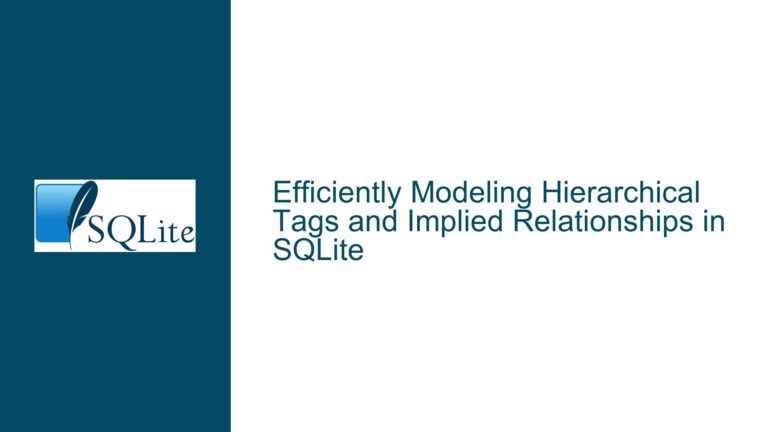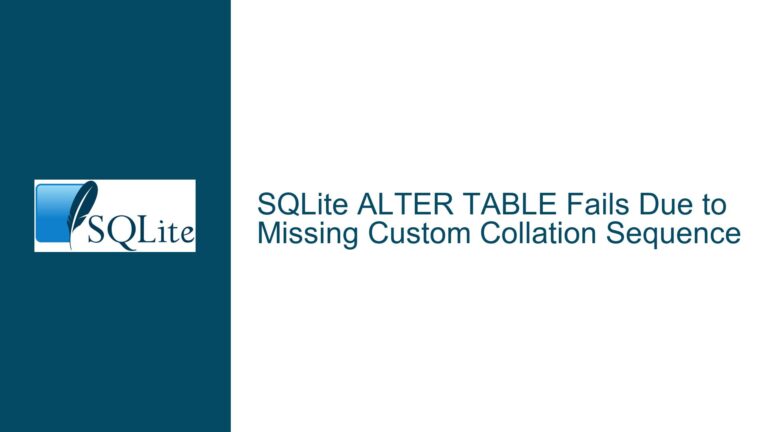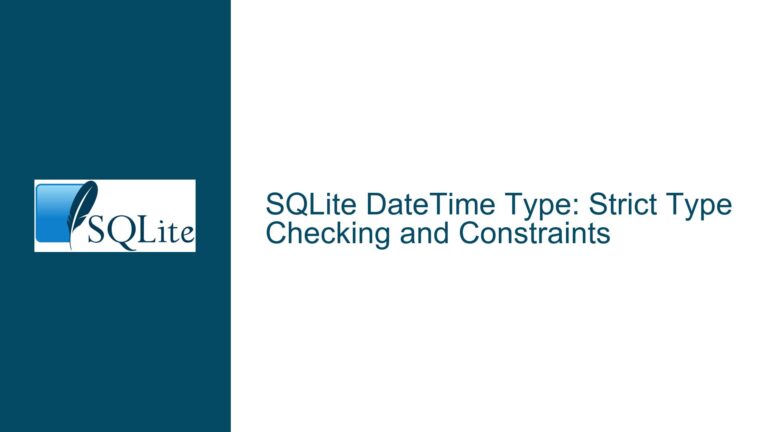the Purpose and Utility of Constraint Names in SQLite
The Role of Constraint Names in SQLite Error Handling and Debugging
Constraint names in SQLite serve a critical role in error handling and debugging, particularly when dealing with constraint violations. When a constraint is violated, SQLite can include the constraint name in the error message, which significantly aids in diagnosing the issue. For example, if a CHECK constraint named check_age_limit is violated, the error message might explicitly mention check_age_limit, making it easier to identify the source of the problem. This is especially useful in complex databases with numerous constraints, where pinpointing the exact constraint that caused the violation can be challenging.
The utility of constraint names extends beyond just CHECK constraints. While SQLite primarily uses constraint names in error messages for CHECK constraints, the SQL standard allows for the naming of other types of constraints as well. This includes constraints like UNIQUE, PRIMARY KEY, FOREIGN KEY, and NOT NULL. Although SQLite does not currently use these names in error messages for all constraint types, the practice of naming constraints is still beneficial for future-proofing and maintaining consistency with the SQL standard.
Moreover, constraint names can be particularly useful in generated columns. A generated column is a column whose value is derived from an expression involving other columns in the same table. When a constraint is applied to a generated column, naming that constraint can help in understanding the relationship between the generated column and the underlying expression. For instance, if a generated column total_price is constrained by a CHECK constraint named check_total_price_positive, the constraint name provides immediate insight into the nature of the constraint, making the schema more readable and maintainable.
In summary, constraint names in SQLite are not just optional labels; they play a vital role in error handling, debugging, and schema documentation. By providing meaningful names to constraints, developers can create more maintainable and understandable databases, especially when dealing with complex schemas and generated columns.
The Impact of Unnamed Constraints on Database Maintenance and Debugging
Unnamed constraints can lead to significant challenges in database maintenance and debugging. When a constraint violation occurs, the absence of a constraint name in the error message can make it difficult to identify the specific constraint that was violated. This is particularly problematic in large databases with numerous constraints, where the lack of named constraints can turn debugging into a time-consuming and error-prone process.
Consider a scenario where a table has multiple CHECK constraints, all of which are unnamed. If one of these constraints is violated, the error message would not provide any specific information about which constraint was violated. This forces the developer to manually inspect each constraint to determine the cause of the violation. In contrast, if each constraint had a meaningful name, the error message would immediately point to the specific constraint, significantly reducing the time and effort required for debugging.
The issue is not limited to CHECK constraints. Unnamed UNIQUE, PRIMARY KEY, and FOREIGN KEY constraints can also complicate database maintenance. For example, if a UNIQUE constraint is violated, the error message would not specify which unique constraint was violated, making it harder to resolve the issue. Similarly, unnamed FOREIGN KEY constraints can make it difficult to understand the relationships between tables, especially when dealing with complex schemas involving multiple foreign keys.
Furthermore, unnamed constraints can hinder schema documentation and understanding. When constraints are named, they serve as self-documenting elements of the schema, providing immediate insight into their purpose and function. This is particularly important in collaborative environments, where multiple developers may be working on the same database. Named constraints make it easier for developers to understand the schema and its constraints, reducing the likelihood of errors and improving overall productivity.
In conclusion, while unnamed constraints may seem like a minor issue, they can have a significant impact on database maintenance and debugging. By naming constraints, developers can create more maintainable and understandable databases, reducing the time and effort required for debugging and improving overall schema clarity.
Best Practices for Naming Constraints in SQLite
Naming constraints in SQLite is a best practice that can greatly enhance the maintainability and clarity of a database schema. When naming constraints, it is important to follow a consistent naming convention that clearly indicates the type and purpose of the constraint. This not only aids in debugging and error handling but also improves the overall readability and documentation of the schema.
One effective naming convention is to use a prefix that indicates the type of constraint, followed by a descriptive name that reflects the purpose of the constraint. For example, a CHECK constraint that ensures the age column is greater than 18 could be named check_age_greater_than_18. Similarly, a UNIQUE constraint on the email column could be named unique_email. This naming convention makes it immediately clear what each constraint does, reducing the need for additional documentation and making the schema easier to understand.
When naming constraints on generated columns, it is particularly important to include the name of the generated column in the constraint name. This helps to clearly indicate the relationship between the constraint and the generated column. For example, a CHECK constraint on a generated column total_price that ensures the value is positive could be named check_total_price_positive. This naming convention not only makes the constraint easier to identify but also provides immediate insight into the purpose of the constraint.
In addition to using descriptive names, it is also important to ensure that constraint names are unique within the schema. This avoids potential conflicts and ensures that each constraint can be uniquely identified. One way to achieve this is to include the table name in the constraint name. For example, a CHECK constraint on the age column in the users table could be named users_check_age_greater_than_18. This naming convention ensures that each constraint name is unique and clearly indicates the table to which it belongs.
Finally, it is important to document the naming convention and ensure that all developers working on the database adhere to it. This consistency is crucial for maintaining a clear and understandable schema, especially in collaborative environments. By following a consistent naming convention and documenting it, developers can create more maintainable and understandable databases, reducing the likelihood of errors and improving overall productivity.
In summary, naming constraints in SQLite is a best practice that can greatly enhance the maintainability and clarity of a database schema. By following a consistent naming convention, including the type and purpose of the constraint, and ensuring unique and descriptive names, developers can create more maintainable and understandable databases, reducing the time and effort required for debugging and improving overall schema clarity.
